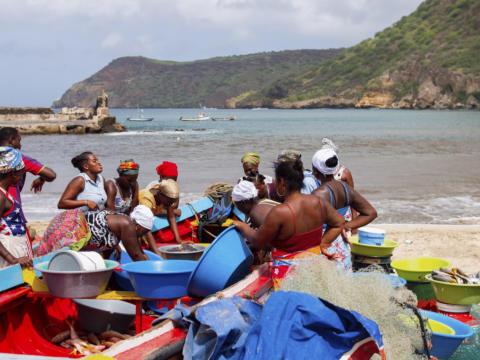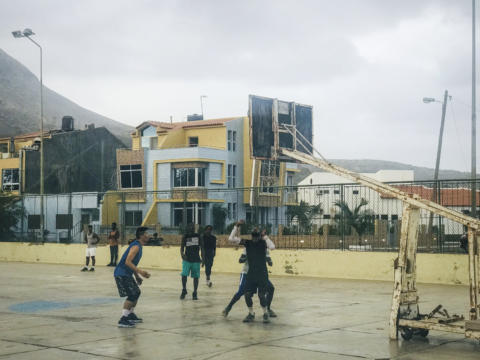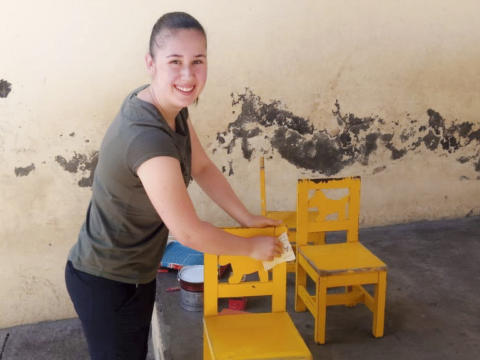Only 420€ per week!
Culture Week
Tarrafal - Cape Verde
Get ready for an action-packed week full of exciting adventures and cultural excursions to learn about Cape Verdean culture!
Throughout the week, you will get to learn the basics of the Cape Verdean Creole language, explore Tarrafal and its surrounding areas and finally immerse in the Cape Verdean culture by receiving a real exposure to the communities and the local areas.
Program Description
The Cape Verdean islands are wonderful, interesting and special. The majority of the Cape Verdean people live in Santiago and Praia, the capital city of the archipelago. Santiago is a wonderfully balanced island. At its heart are craggy mountains cut into exotic outlines and afforested in their lower slopes. There are green valleys with agriculture, in the south, there are plantations and some awesome beaches with black and white sand in the north, where fishermen bring in a lot of fish every day. During the Culture Week, you will be participating in various activities and get acquainted with the Cape Verdean culture, study the local language and explore Tarrafal and its beautiful surrounding areas.
Aims & Objectives
The aim and objective are to introduce you to the authentic Cape Verdean culture and immerse you into it. By doing so, you will experience the best and the closest you can get to this impressive culture.
Schedule
Monday
- On Monday, you will have breakfast and then get an introduction about the Cape Verdean traditions and culture. We will do initial documentation before your program begins including the signing of the Code of Conduct and collection of passport and visa copies.
- Then you will attend a Basic Kriolu class to learn about the local language. This is critical because the majority of people speak Kriolu, Portuguese or French here. So it may come in handy if you know some of these languages.
- Then we will leave to visit local supermarkets and ATMs and explore the surroundings of our centre.
- We will have lunch at the centre.
- After lunch, you will visit Mar De President Beach and spend some time on the beach before returning back to the centre for dinner.
Tuesday
- After breakfast, you will attend a one hour Basic Kriolu class to continue your course. Today you will learn how to talk about Days of the Week and months in Kriolu.
- Then you will visit the Museum, Tarrafal concentration camp, local Market.
- You will return to the centre for lunch.
- In the afternoon, you will visit Ribera Das Prat.
Wednesday
- After breakfast, you will attend another one hour Basic Kriolu class to where you will learn useful words for communication and spellings.
- Then you will visit Traz di Munti to learn pottery. It’s going to be a great time to learn and explore your creative skills.
- Then you will have lunch in the village.
- After lunch, you will visit a lighthouse.
Thursday
- After breakfast, you will attend one hour Basic Kriolu class and start learning how to make sentences.
- Then we will leave the centre and visit the Project site for the following week.
- You will have lunch and continue at project site till the afternoon.
Friday
- After breakfast, we will have our last Basic Kriolu classes and start making phrases.
- Then we will head out to go on a fishing trip with the local fishermen.
- We will return to the center for a Barbeque lunch.
- After lunch, it is your free time to relax.
Note: This schedule can be changed and/or amended depending on weather conditions, local conditions and unforeseen circumstances.
Participant Criteria & Requirements
Standard Requirements
Minimum age: –
Maximum age: –
Minimum English level: Basic
CRB required: On Signup
Passport copy required: On Signup
Resume copy required: No
Required qualification: None
Additional Requirements
Yellow fever vaccination is a mandatory requirement for all participants arriving in Cape Verde.
For participants below 18, parental consent is required and for participants above 65, medical clearance is required.
Additional Equipment
No specific equipment necessary.
Location
The city is named after the indigenous plant Tarrafe, (Tamarix senegalensis). Also called Mangui or Mangue, it is situated on the northern part of the island of Santiago. A fishing port situated on the northwestern coast and also is a municipality.
About the Accommodation
You can expect to share a room on single gender basis. The bathroom is shared and western toilets are available.
Food Arrangements
The meals will contain a mix of local and various types of Western food.
Facilities
There are ATMs, mini marts, some shops and restaurants available in the city center.
Activities & Events
No scheduled activities outside the program.
Sights & Surroundings
- Tarrafal beach
Transportation
From this location we do not provide free transport to other locations.
Quick Facts
Name: Republic of Cabo Verde
Population: 532,913 (2016)
Capital: Praia
Language: Portuguese, Cape Verdean Creole
Currency: Cape Verdean Escudo (CVE)
Time zone: CVT (UTC-1)
Country Information
The beautiful islands of the Cape Verde were initially uninhabited until it was discovered by the Portuguese in the 15th century. The country flourished during the 16th and the 17th centuries due to the Atlantic slave trade. But with the decline of the slave trade in the 19th century, the country experienced an economic crisis. Yet the location of the island made it survive as it became a significant commercial center in the 19th century as the location was perfect for re-supply of the ships. In the present day context, the economy of the country is mostly relying on the services provided by the country targeting the growing tourism industry.
Climate
Cape Verde has a mild climate compared to the mainland of Africa with an average high temperature of about 26 °C during February and 31 °C in September. The country has an irregular rain pattern in the months between August and October and it is in September that the country experiences its maximum rainfall. The country can boast about the rich vegetation and the forests that provides a rainforest habitat although the close proximity to the Sahara is makes most islands with no mountains mostly dry. The islands as initially were isolated, the existence of a number of endemic species mostly the birds and reptiles can be seen although the existence is threatened by the human developments.
Culture
As the country was discovered by the Portuguese, the culture is immensely influenced by them as the rural Portuguese practices are displayed in the social and cultural patterns of the country. The closeness to the church activities and the football games act as way of interaction between the locals for entertainment.
Transportation
By bus
For travelling within the islands, the most famous transportation is the minibuses which are known as “Yasi” which can accommodate around 12 to 14 passengers. In addition, the modified pickup truck and the cabs which are sometimes covered provide the transport facilities for shorter distances and in rural areas.
By Taxi
Taxis can mostly be found in the cities of Praia and Assomada, and they have unique colored taxis in these two cities, where taxis painted in beige are based in Praia and the taxis painted in white are based in Assomada. The taxis sometimes have a meter fixed to it although they hardly use it as the rates which are usually accepted are cheaper than the ones the metered taxis would count.





